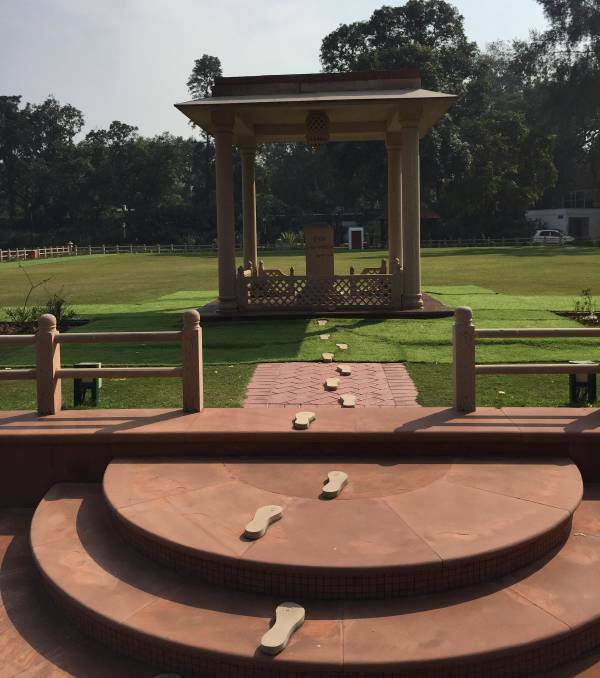There are many places in this exotic country worth a trip away from the usual tourist traps, Lydia Roberts writes.
About 15 minutes from the heart of Delhi lies a path of stone steps that immortalise one of the greatest leaders of the 20th century.
Create a free account to read this article
$0/
(min cost $0)
or signup to continue reading
Mahatma Gandhi led India to independence from the British and lived his final days in a white bungalow, where he took those final, fateful steps in 1948.
These days the bungalow and site of Gandhi’s assassination, Gandhi Smriti, is a key tourist attraction, left in much the same way Gandhi had lived.
There is his spinning wheel, walking stick, shoes and bed around which has been built an interactive museum.
India may be temporarily off the bucket list, however, now is a good time to plan a trip to this diverse country of 1.3 billion people.
It’s also a good time to read William Dalrymple’s The Anarchy, a constant companion for any tourist to India.
This just-published epic tells the story of the British East India Company’s insidious spread through this gentle country and how the British came to rule over India from 1858 to 1947, a year before Gandhi’s death.
Visit the hundreds of forts and palaces across the country and read about them at night in The Anarchy, snuggled in bed.
A three-hour journey from India’s capital, Delhi, where most tourists start their Indian adventure, lies Agra Fort.
This world heritage-listed site was the main home of the Mughals, who ruled India from 1526 to when they surrendered to the British in 1857.

Dalrymple charts when in 1774, during a siege of the fort, more than 5000 cannonballs were fired at its walls; some of those marks can still be seen today.
Stroll around the fort’s ruins and garden, which touches the banks of the Yamuna River, from where you can view the Taj Mahal.
No visit to India is complete without seeing this monument to love and loss. Up to eight million tourists visit the monument every year. Our guide, a handsome and witty 40-year-old father, Bhagirath Purohit (“call me Baggy”) advised a tour of the Taj Mahal in the afternoon.
He was right; if you visit the Taj after 3pm, many tourists would have left and there is ample time to explore this mausoleum which cost $1 billion to build (in today’s currency) in the middle 1600s.
An out-of-the-way town just a four-hour drive west of Agra is Bundi, founded in the 12th century.
Rudyard Kipling is said to have stayed at Bundi’s summer palace, the Sukh Mahal, which sits on Jait Sagar Lake and from where he drew inspiration for his novel, Kim.
Bundi stretches around the lake, overlooked by the remarkable Taragarh Fort.
Locals are trying to encourage more tourists to visit Bundi and there are a good number of cheap hostels, as well as restaurants offering excellent curries.
We “glamped” at the Ummaid Bagh Resort, on the shores of the lake.
Each tent has its own bathroom and comfortable beds with adequate blankets.
You can dine at the resort by the lake or find a cheap eat in Bundi, with its many bazaars, shops and downtown market.
Take a tuk-tuk and explore the town’s winding streets.
While in the town, try a Laal Maas, a classic Rajasthani curry made with chillies, ghee and coriander leaves.
If there is one city you must visit in India, it is Udaipur. Its dramatic setting, on the shores of Lake Pichola, makes this a favourite setting for Hollywood and Bollywood producers, for films such as Octopussy (1983), Heat and Dust (1983) and The Best Exotic Marigold Hotel (2011).
Take a ferry ride and see the city, often referred to as the “Venice of the East”, from its shores.
The old city has good fabric shops, where tailors can make anything from shirts to business suits, overnight.
Return to Delhi and visit an out-of-the-way square, Connaught Place.
This fading commercial and financial centre is based upon the Georgian style and architecture of Bath’s Royal Crescent.
A sad reminder of India’s brutal British heritage.
Don’t forget to pack
- Essential reading: The Anarchy, William Dalrymple
- Must-have medicine: Water purifier tablets
- Just in case: Pack warm clothes if travelling Dec-Mar




